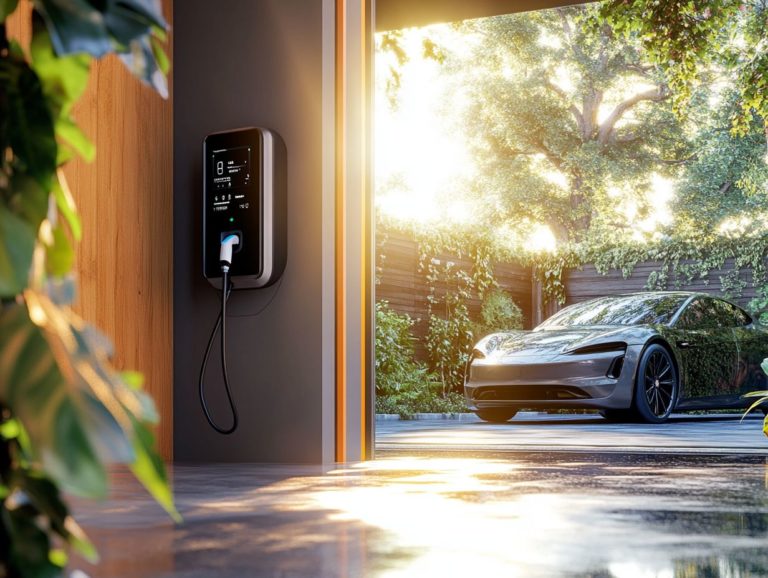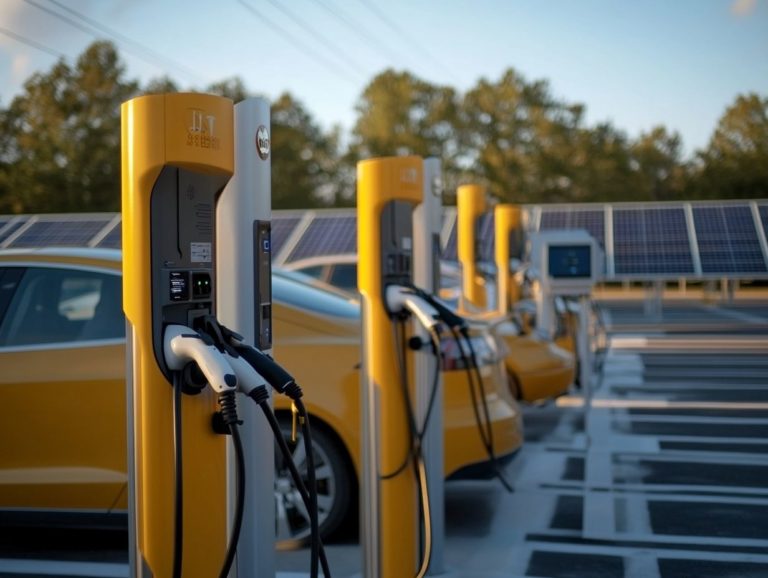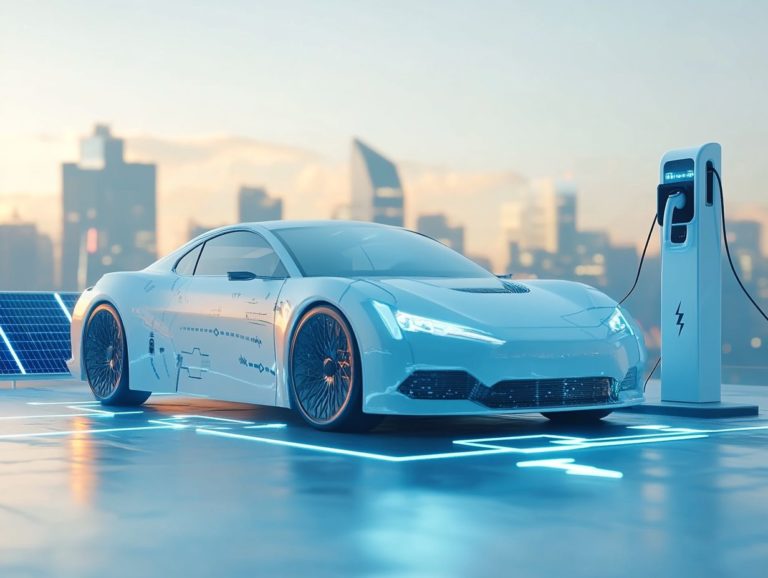exploring the global ev charging landscape
The electric vehicle (EV) revolution is reshaping your roads and redefining the future of transportation. As the demand for greener solutions escalates, it is essential to grasp the nuances of the EV charging landscape.
This article ventures into global trends fueling EV growth, the challenges surrounding charging infrastructure, and the array of charging options available.
You ll discover the key players in the charging network, government initiatives, and innovations paving the way for a sustainable future. Join us as we dive into the thrilling world of EV charging innovation!
Contents
- Key Takeaways:
- The Rise of Electric Vehicles (EVs)
- Challenges in the EV Charging Landscape
- Types of EV Charging
- Global EV Charging Networks
- Government Initiatives and Policies
- Innovations in EV Charging Technology
- The Future of EV Charging
- Frequently Asked Questions
- What is the global EV charging landscape?
- Why is exploring the global EV charging landscape important?
- What Types of Charging Stations Are Available in the Global EV Charging Landscape?
- How Accessible Is EV Charging Around the World?
- What Are Some Challenges in the Global EV Charging Landscape?
- How Is the Global EV Charging Landscape Expected to Change in the Future?
Key Takeaways:

The global EV market is rapidly growing, indicating a shift towards sustainable transportation. The main challenges in the EV charging landscape are infrastructure limitations and cost/accessibility issues. Different types of EV charging, such as level 1, level 2, and DC fast charging, offer varying speeds and capabilities.
The Rise of Electric Vehicles (EVs)
The rise of electric vehicles (EVs) marks a transformative shift toward sustainable transportation. This movement is driven by technological advancements and greater environmental awareness.
Countries such as Norway and the European Union are at the forefront, showcasing impressive electric car sales and increasing adoption rates among urban dwellers.
This transition embodies a strong commitment to reducing carbon emissions and advancing electric mobility, with a strong emphasis on promoting both light-duty and heavy-duty electric vehicles.
Global Trends and Growth of EVs
The global landscape of electric vehicle sales reveals a remarkable surge in EV adoption across various regions. Trailblazers like China and Norway are leading the charge in market growth.
In 2022, the International Energy Agency (IEA) reported that global electric vehicle registrations skyrocketed to nearly 10 million a staggering 60% increase from the previous year. Norway, in particular, stands out with an impressive EV market share exceeding 54%. This success highlights how strong government incentives and a well-developed charging infrastructure can encourage consumers to transition to electric mobility.
Meanwhile, Mexico may have a lower adoption rate, but it is gradually gaining momentum, driven by heightened environmental awareness and escalating fuel prices.
China, however, remains unparalleled, commanding approximately 60% of the world’s electric vehicle sales. This dominance is fueled by advancements in battery technology and a robust supply chain that supports mass production. These trends highlight the dual importance of technological innovation and the evolving consumer preference for cleaner, sustainable transportation solutions.
Challenges in the EV Charging Landscape
Despite the promising rise of electric vehicles, notable challenges persist within the EV charging landscape. The availability and scalability of charging infrastructure are particularly crucial as they significantly influence consumer experience and play a vital role in promoting wider EV adoption.
Infrastructure Limitations
Infrastructure limitations pose a significant obstacle to the widespread adoption of electric vehicles. A lack of sufficient charging points and networks can undermine consumer confidence.
As the world increasingly embraces sustainable alternatives, the current state of charging infrastructure reveals notable gaps. Many regions lack adequate charging hubs, leaving potential EV owners anxious about range during their travels.
The inability of different charging networks to work together compounds these issues, as users often encounter compatibility problems when attempting to use various charging stations. Such challenges not only deter potential buyers but also frustrate current EV owners, making the transition from traditional vehicles even less appealing.
To foster an environment that supports broader EV adoption, it is crucial to address these infrastructure limitations.
Cost and Accessibility Issues
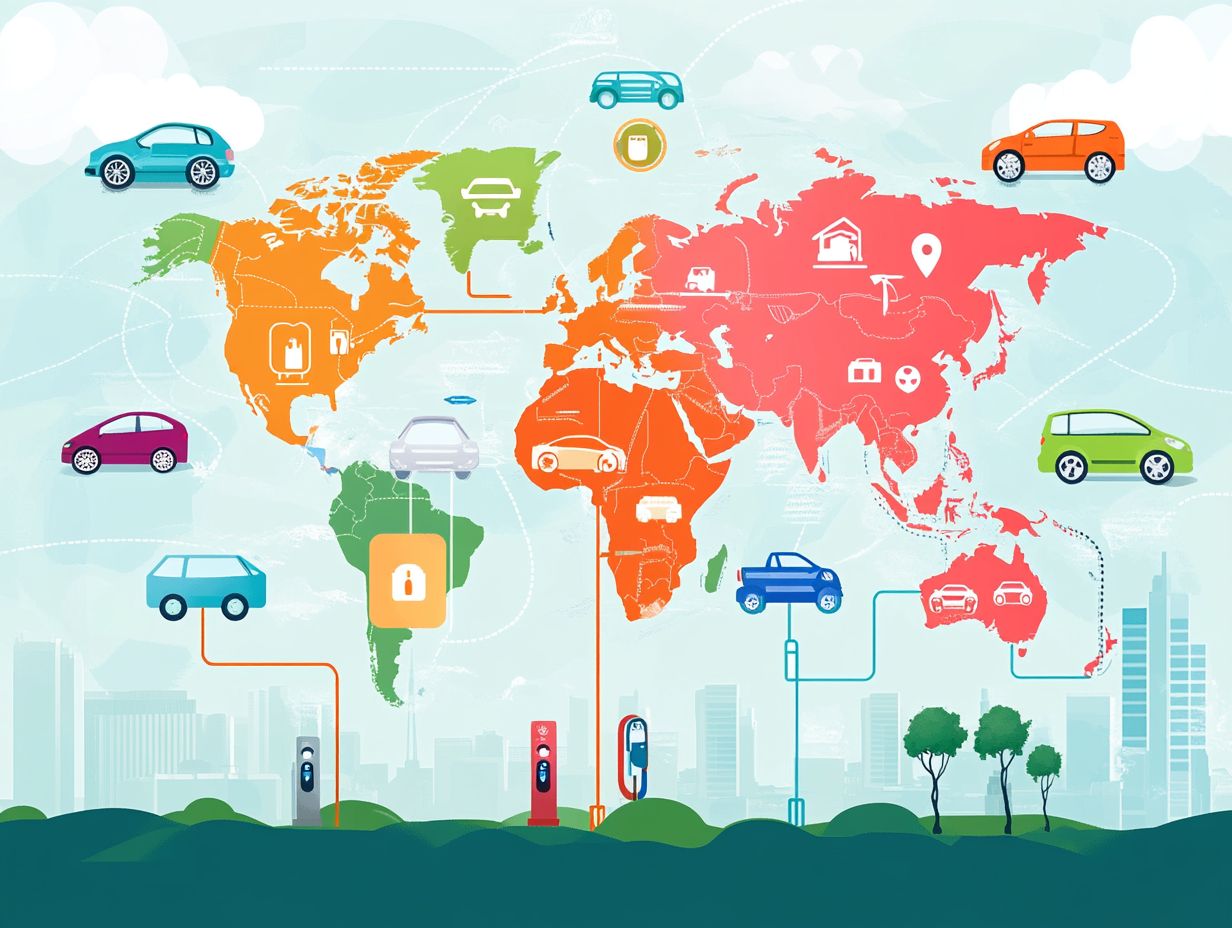
Cost and accessibility issues play an important role in your decision to adopt electric vehicles. High installation costs for private chargers and limited access to public charging stations can easily discourage you from making the switch to EVs.
The financial burden of setting up home charging systems often makes the leap to electric feel daunting.
Public charging options can be frustrating. Costs fluctuate significantly based on location and time. This variability complicates budgeting and leads to uncertainty about fully committing to an electric vehicle.
You ll likely weigh the convenience of charging at home against the potential costs associated with public systems. This choice shapes your personal decisions and broader trends in the EV market.
Types of EV Charging
Understanding the different types of EV charging helps you charge smarter and enjoy your electric vehicle experience!
Whether it s opting for convenient home charging solutions or navigating advanced public charging technology, your knowledge will enhance your journey in the world of electric vehicles.
Level 1, Level 2, and DC Fast Charging
The three primary types of EV charging Level 1, Level 2, and DC fast charging each present unique advantages tailored to your specific charging needs.
Level 1 charging is like plugging your car into a regular outlet at home. It s often sufficient for home use, allowing you to recharge your electric vehicle overnight without any complicated setup.
On the other hand, Level 2 charging is faster and often found in public charging stations. These systems operate on a 240-volt outlet, delivering significantly quicker charging times, making them ideal for both residential and commercial spaces.
With DC fast charging, you can hit the road again in just 30 minutes! These stations are designed for rapid top-ups, capable of replenishing a battery to 80% perfect for transit and long road trips.
With advancements in technology, charging speeds and safety features have improved remarkably across all types, ensuring you can power your vehicle efficiently while minimizing downtime.
Global EV Charging Networks
Global EV charging networks play a crucial role in the smooth operation and widespread adoption of electric vehicles. They consist of well-designed systems featuring both public and fast chargers, ensuring that electric vehicle drivers have convenient access wherever they go.
Key Players and Coverage Areas
Key players in global EV charging networks include major manufacturers and innovative start-ups like Tesla, Gogoro, and Ampersand. These companies work diligently to expand public chargers and charging systems.
They collaborate with local governments, energy providers, and tech firms to create a robust ecosystem designed to meet your needs effectively.
By establishing strategic partnerships, they enhance market coverage, making it easier for you to access charging stations across various regions.
This diverse network highlights the different approaches in distinct markets. Some prioritize fast charging solutions, while others focus on widespread accessibility.
The global variety of charging networks reflects cultural and infrastructural differences. This prompts tailored strategies that cater to local demographics and driving habits.
This ultimately shapes the future of electric mobility, ensuring that your journey is as seamless as possible.
Government Initiatives and Policies

Government initiatives and policies are crucial in shaping the electric vehicle charging landscape. They offer essential incentives and establish a regulatory framework that promotes the deployment of electric vehicle supply equipment (EVSE), ultimately enhancing overall charging capabilities.
Incentives and Regulations for EV Charging
Incentives and regulations surrounding EV charging have profoundly impacted your journey toward adopting electric vehicles. They offer significant financial support and clear guidelines for both public and private charging infrastructure.
Many governments have rolled out tax credits, rebates, and grants. These are designed to lower the installation costs of charging stations. This strategic move encourages municipalities and businesses alike to invest in this vital infrastructure.
Rules and guidelines are also important. They determine how many chargers are necessary and where they should be placed. This enhances coverage and influences your decisions as a potential EV owner access to nearby charging options can sway your choice significantly.
As these incentives continue to evolve, they cultivate a more inviting landscape for electric vehicle adoption. This makes it easier for you to make the switch.
Innovations in EV Charging Technology
Innovations in EV charging technology are propelling you into the next generation of charging solutions.
From wireless charging systems that eliminate the need for cumbersome cables to advanced battery swapping technologies, these developments significantly enhance the efficiency and convenience of your EV charging experience.
Wireless Charging and Other Advancements
Wireless charging stands at the cutting edge of charging technology, granting you the freedom of seamless energy transfer without the hassle of cables. Innovations like battery swapping and fast chargers redefine the way you think about charging.
This advanced charging method enhances your convenience and minimizes wear and tear on your charging ports, ultimately extending your battery life. With the advent of wireless systems, you can simply park over a charging pad, and voil power transfer begins automatically.
On another front, battery swapping technology offers you the ability to quickly exchange depleted batteries for fully charged ones. This dramatically reduces downtime and alleviates range anxiety.
Together, these innovations are poised to transform your interaction with electric vehicles. They create a more efficient and user-friendly experience in the realm of electric mobility.
The Future of EV Charging
Get ready! The future of EV charging is on the brink of amazing advancements, fueled by ongoing innovations in charging technology and the escalating global demand for electric transportation.
This evolution promises to deliver heightened accessibility and convenience for you, the consumer.
Predictions and Potential Developments
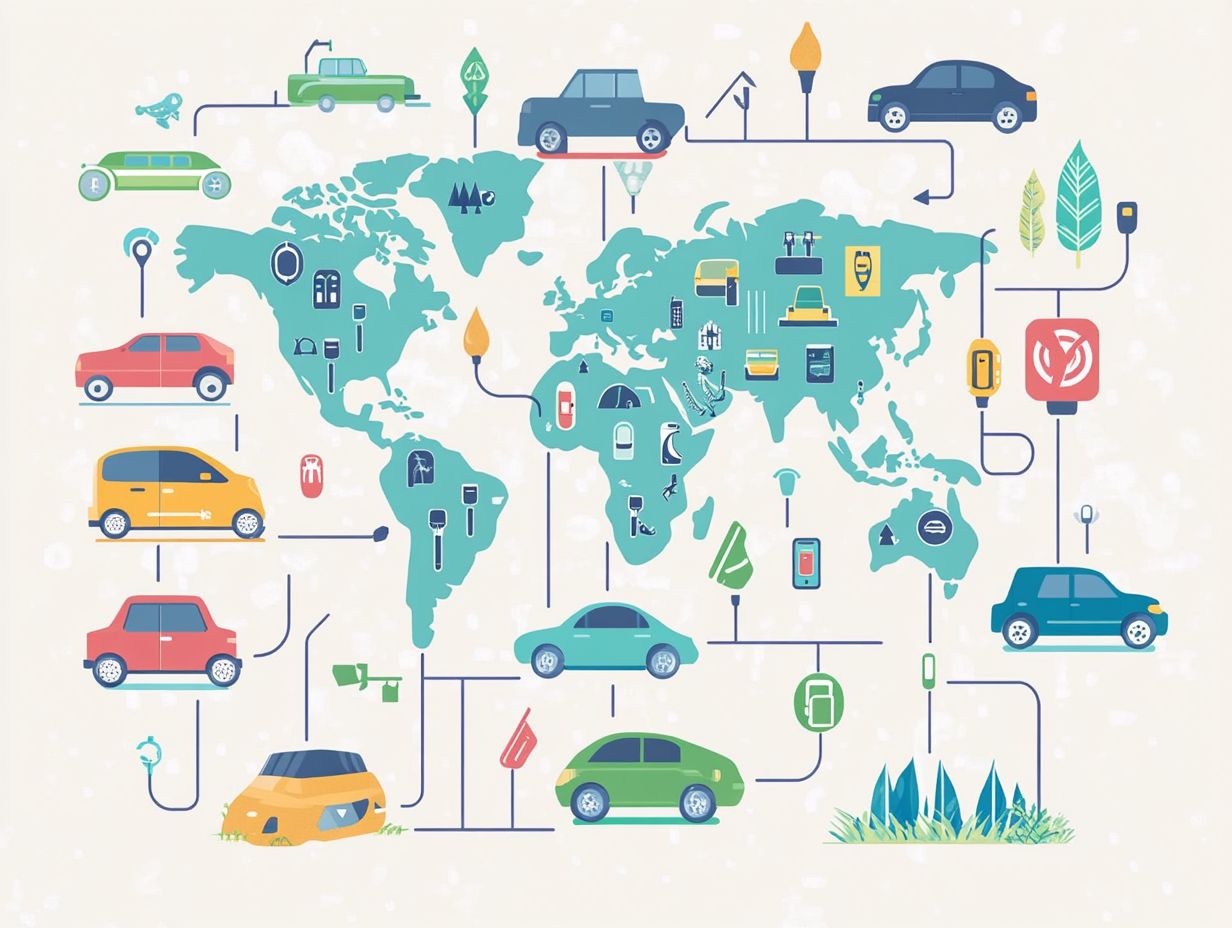
Predictions for the future of EV charging suggest a remarkable transformation in both infrastructure and technology. This paves the way for greater adoption of electric vehicles and an elevated consumer experience.
Exciting advancements are happening now. Expect charging stations to become faster, more accessible, and seamlessly integrated with renewable energy sources. This means the charging process will not only be more efficient but also environmentally friendly.
The rise of ultra-fast chargers could significantly minimize wait times. This makes it even more enticing for you to consider electric vehicles as a genuine alternative to traditional gasoline cars.
Innovations like wireless charging and smart grid technologies are ready to provide a seamless experience. They will ultimately boost your confidence in electric vehicle ownership and reshape the entire landscape of electric transportation.
Frequently Asked Questions
What is the global EV charging landscape?
The global EV charging landscape refers to the infrastructure and services available for electric vehicle (EV) charging around the world. This includes the different types of charging stations, their locations, and how EV charging is transforming urban planning to enhance overall adoption and accessibility.
Why is exploring the global EV charging landscape important?
Exploring the global EV charging landscape is important because it gives insight into the current state and future potential of EVs, including the evolution of EV charging technology. It can also help individuals and businesses make informed decisions about owning or investing in EVs.
What Types of Charging Stations Are Available in the Global EV Charging Landscape?
There are three main types of charging stations: Level 1, Level 2, and DC Fast Charging. Level 1 chargers are the slowest and are typically used at home.
Level 2 chargers are faster and often found in public spaces. DC Fast Charging is the quickest option but is less common.
How Accessible Is EV Charging Around the World?
EV charging accessibility varies greatly worldwide. Norway and the Netherlands have many charging stations and offer rewards for EV owners.
In contrast, some developing countries struggle with limited charging infrastructure.
What Are Some Challenges in the Global EV Charging Landscape?
A significant challenge in the EV charging landscape is the lack of standardization. Different regions have varying types of charging stations, making it tough for EV owners to charge while they travel.
How Is the Global EV Charging Landscape Expected to Change in the Future?
The global EV charging landscape will continue to grow as the demand for electric vehicles rises. We can expect advanced charging technologies and greater accessibility.
Renewable energy will also play a key role in this evolution. Government initiatives and investments will shape the future of EV charging.


